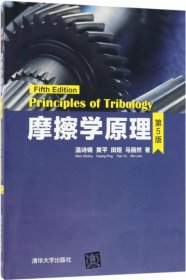
摩擦学原理(第5版)
¥ 65 6.6折 ¥ 98 八五品
仅1件
作者温诗铸、黄平、田煜、马丽然 著
出版社清华大学出版社
出版时间2018-05
版次5
装帧平装
上书时间2024-04-16
- 在售商品 暂无
- 平均发货时间 2小时
- 好评率 暂无
- 最新上架
商品详情
- 品相描述:八五品
图书标准信息
- 作者 温诗铸、黄平、田煜、马丽然 著
- 出版社 清华大学出版社
- 出版时间 2018-05
- 版次 5
- ISBN 9787302500087
- 定价 98.00元
- 装帧 平装
- 开本 16
- 纸张 胶版纸
- 页数 484页
- 字数 1千字
- 【内容简介】
-
《摩擦学原理(第5版)》反映了摩擦学研究进展以及作者和同事们从事该领域研究的成果,系统地阐述摩擦学的基本原理与应用,全面反映现代摩擦学的研究状况和发展趋势。 全书共22章,由润滑理论与润滑设计、摩擦磨损机理与控制、应用摩擦学等三部分组成。除摩擦学传统内容外,还论述了摩擦学与相关学科交叉而形成的研究领域。本书针对工程实际中各种摩擦学现象,着重阐述在摩擦过程中的变化规律和特征,进而介绍基本理论和分析计算方法以及实验测试技术,并说明它们在工程中的实际应用。 《摩擦学原理(第5版)》可作为机械设计与理论专业的研究生教材和高等院校机械工程各类专业师生的教学参考书,亦可供从事机械设计和研究的工程技术人员参考。
- 【作者简介】
-
温诗铸,生于1932年,学院院士,清华大学教授。现任摩擦学名誉主任。长期从事机械设计与理论专业的和研究,出版学术著作摩擦学(共4版)、弹流体动力润滑、耐磨损设计、纳米摩擦学(共两版)、界面科学与、技术、界面力学和principle of tribology(共两版)等7部共12版。所主持的研究项目共获奖26项。2002年获何梁何利科学与技术进步奖,2009年获中国机械工程学会摩擦学分会优选成奖,2012年获机械工程学会科学技术奖:2015年获world tribology council颁发的the 2015 tribology gold medal。
黄,生于1957年,工学博士,现任华南理工大学教授、博士生导师,课程指导委员会委员,清华大学摩擦学学术委员。获名师、万人计划名师等称号,院特殊津贴获得者。出版专著摩擦学界面力学流体润滑计算非牛顿流体润滑等。先后负责和参与科研项目20多项,获专利9项。获自然科学、技术发明各一项,省部级科技奖励7项。
田煜,生于1975年,工学博士,现为清华大学机械工程系教授,摩擦学副主任。2014年受聘长江学者奖励计划特聘教授,并获杰出青年科学资助。担任journal of bio amp; tribocorroion主编,biotribology,friction编委。研究方向为机械表/界面行为控制机理与应用。 - 【目录】
-
Part OneLubrication Theory and Lubrication Design
Chapter 1Properties of lubrication film
1.1Lubrication states
1.2Density of lubricants
1.3Viscosity of fluids
1.4NonNewtonian properties and rheological model
1.5Lubricant wettability
1.6Measurement and exchange of viscosity
References
Chapter 2Basic theory of hydrodynamic lubrication
2.1Reynolds equation
2.2Hydrodynamic lubrication
2.3Basic elasticity theory of contact problems
2.4Elastohydrodynamic lubrication (inlet analysis)
2.5Grease lubrication
2.6Elastohydrodynamic lubrication state diagrams
References
Chapter 3Numerical methods of lubrication calculation
3.1Numerical solutions of Reynolds equation
3.2Numerical solutions of energy equation
3.3Numerical solutions of elastohydrodynamic lubrication
3.4Multigrid level method used in lubrication problems
References
Chapter 4Lubrication design of typical mechanical elements
4.1Slider and thrust bearing
4.2Journal bearing
4.3Hydrostatic bearing
4.4Squeezing bearing
4.5Dynamic bearing
4.6Gas bearing
4.7Rolling contaet bearing
4.8Gear lubrication
4.9Cam lubrication
References
Chapter 5Lubrication of special fluid medias
5.1Magneto fluid lubrication
5.2Micropolar fluid lubrication
5.3Liquid crystal lubrication
5.4Double electric layer effect in water thin film lubrication
5.5Emulsion lubrication
References
Chapter 6Transformation of lubrication states and nano thin film lubrication
6.1Transformation of lubrication states
6.2Nano film lubrication of liquid
6.3Numerical analysis of thin film lubrication
6.4Nano film lubrication of gas
References
Chapter 7Boundary lubrication and additives
7.1Types of boundary lubrication
7.2Theory of boundary lubrication
7.3Additives of lubricant
References
Chapter 8Lubrication failure and mixed lubrication
8.1Influence of roughness and material viscoelastic property on lubrication
failure
8.2Influence of fluid limiting shear stress on lubrication failure
8.3Influence of temperature on lubrication failure
8.4Mixed lubrication state
References
Part TwoFriction and Wear Mechanisms and Friction Control
Chapter 9Surface topography and surface contacts
9.1Parameters of surface topography
9.2Statistic parameters of surface topography
9.3Rough surface contacts
References
Chapter 10Soliding friction and its applications
10.1Basic characteristics of friction
10.2Macro friction theory
10.3Micro friction theory
10.4Sliding friction
10.5Other friction problems and friction control
References
Chapter 11Fretting friction and its applications
11.1Development and classification of fretting tribology
11.2Theory of fretting friction
11.3Approches of improving fretting performance
11.4Researches on the applications of fretting tribology
References
Chapter 12Rolling friction and its applications
12.1Basic theories of rolling friction
12.2Wheelrail rolling friction and thermal analysis
12.3Application of rolling friction theory in design of lunar rover
vehicle
References
Chapter 13Wear characteristics and mechanisms
13.1Wear classification
13.2Abrasive wear
13.3Adhesive wear
13.4Fatigue wear
13.5Corrosion wear
References
Chapter 14Macro wear laws and wear theories
14.1Materials of friction pair
14.2Curves of wear processes
14.3Surface quality and wear
14.4Adhesive wear theory
14.5Energy wear theory
14.6Spalling theory and fatigue wear theory
14.7Wear calculation
References
Chapter 15Antiwear designs and surface coatings
15.1Choice of lubricants and additives
15.2Principles of friction pair material choice
15.3Surface coatings
15.4Measurement of coating properties
References
Chapter 16Tribological experiments and state detection
16.1Methods and equipments of tribological experiments
16.2Measurement of wear
16.3State analysis of friction surface
16.4Detection of wear states
16.5Analysis of wear failure
References
Part ThreeApplied Tribology
Chapter 17Micro tribology
17.1Micro friction
17.2Micro contact and adhesive phenomena
17.3Micro wear
17.4Molecular film and boundary lubrication
References
Chapter 18Metal forming tribology
18.1Mechanics basics in forming technology
18.2Forge tribology
18.3Drawing tribology
18.4Milling tribology
18.5Cutting tribology
References
Chapter 19Biological tribology
19.1Fundamental of mechanics on biological soft tissue
19.2Characteristics of liquid lubricant of joints
19.3Men and animal joint lubrication
19.4Friction and wear of joint
19.5Study on other biological tribology
References
Chapter 20Space tribology
20.1Space machinery and features of space tribology
20.2Analysis of space tribological properties
20.3Space lubricants
20.4Features of space lubrication
20.5Accelerating life tests and equipments
References
Chapter 21Ocean tribology
21.1Ocean enriro ment and ocean tribology characteristics
21.2Systems and equipments in ocean tribology
21.3Tribology characteristics of ocean materials
21.4Derelopment trend of ocean tribology
References
Chapter 22MEMS tribology
22.1Tribological problems in MEMS
22.2Friction analysis of MEMS
22.3Study on micromotor friction
22.4Wear analysis of MEMS
References
ChineseEnglish List and Index
相关推荐
— 没有更多了 —



















以下为对购买帮助不大的评价